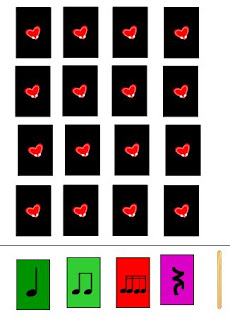For many years, I’ve been tweaking my process for teaching meter/ time signatures. I wish teaching this were just as easy as saying, “In 2/4, there are 2 beats in every measure, and in 4/4, there are 4 beats in every measure,” but as we all know, it is much more complicated than this. In this blog post, I'll detail some strategies that have worked well for me in teaching meter or time signature.
In order for students to understand time signature, they need to feel that the first beat of every measure is the strongest. They need to be able to track measures. They need to be able to figure out where the barlines should go (which is really a practice of rhythm, as they need to know how many beats each rhythm gets!) They need to learn how to perform basic conducting patterns. They need to understand why we use meter to divide music into measures. (Not to mention duple vs. triple meter. When should we teach ¾? 6/8?) This is a lot of information to learn! I’ve heard of some music teachers teaching 2-beat meter, or 2/4, to first graders, but in my experience, all of those barlines and measures and rhythms can be quite confusing for first graders. I like to just start having first graders feel strong beats and weak beats. Then, in second grade, we dive into 2-beat meter.
During my college years, I worked closely with the Dalcroze professor at my school (he gave me free pedagogy lessons, which was incredible. I owe so much to him!) I love using Dalcroze-inspired lessons when working with meter, because students need to physically be able to feel the meter—the strong beats and weak beats, the division of each—and physical activities are great for this! Tennis ball activities are a favorite of mine when preparing and practicing meter—having students bounce on the strong beat and catch on the weak beat, switching between different meters to see if students can hear the difference. Students can also sing a known song and bounce and catch the tennis balls as they sing.
I became even more interested in my teaching process for meter this year when I noticed my daughter—who does very well in music and in academics—struggle with the concept of tracking measures and barlines. She is one of the best readers in her class, yet something about meter wasn’t clicking, even though the students had previously learned 2-beat meter and were now working on 4-beat meter. So I went back to the drawing board and tried a few more ideas. For barlines, I started using popsicle sticks, like in the SMART board file below:
Something about using the popsicle sticks clicked with her, as well as a few other students. I also did learning centers for 4-beat meter. In one of the learning centers, students had to play rhythm patterns on drums. The rhythm cards had two measures in 4-beat meter, and I asked the students to play in small groups, so that the first beat of each measure sounded stronger than the other beats. This seemed to solidify the idea that the first beat of every measure is the strongest.
I also had students work with puzzle pieces to create their own compositions. Each puzzle piece was like a measure and should have four beats on it, but they had to be careful—some of the pieces had less than 4 beats! This was a great way to solidify the understanding of a half note lasting for 2 beats! (Don’t you love arguments between students about how long a half note lasts for? I’ll take those arguments any day over who is first in line!) The puzzle pieces looked like this (and will be in an upcoming set):
Students also had to create their own composition with a glyph, by following the directions and choosing certain rhythms for each measure based on their likes. This was a good exercise in following directions, and gave us some neat compositions to play on instruments!
After several of these activities, I did a summative assessment, and am happy to report that she answered most of the questions correctly, and was able to compose 2 measures in 4-beat meter, putting the barlines in the correct place. Hooray! The rest of the class also did well, and I felt much better about moving onto the next concept (Ti-tika, here we come!)
I’ve compiled some activities, lessons, and visuals into “Songs and Activities to Teach 2-beat meter,” shown below.
Have a great weekend!




















Meter is an element that I think often gets dropped by the wayside or tossed casually into the curriculum. There are so many rhythms and pitches to teach them, it is easy to tack meter on almost as a afterthought. I have been trying to be more conscious about teaching it by steps this year. In fact, I attended two different workshops on meter at the OAKE conference this past weekend. I love the ideas you shared here and will definitely have to check out your 2 Meter packet on TeachersPayTeachers.
ReplyDelete